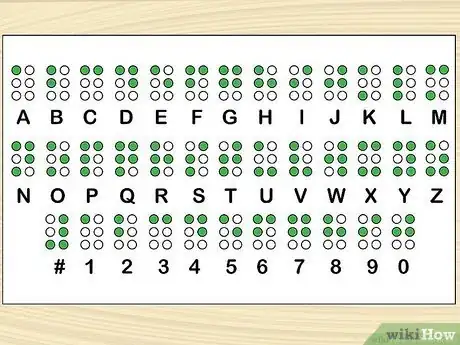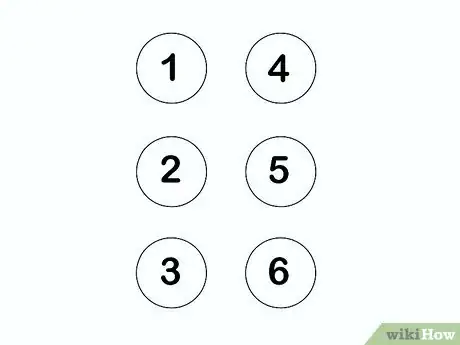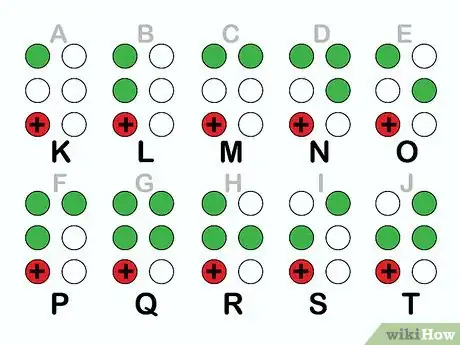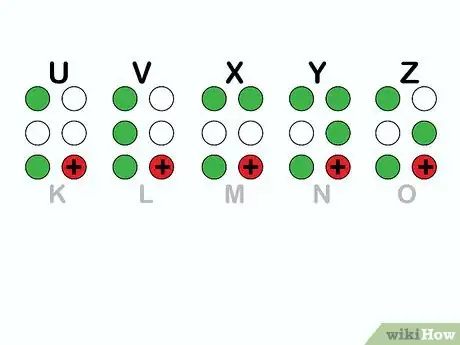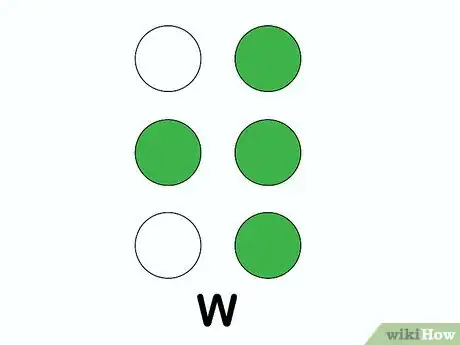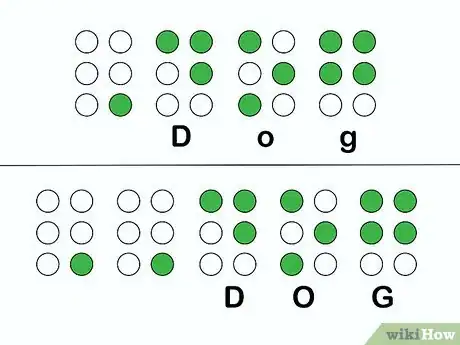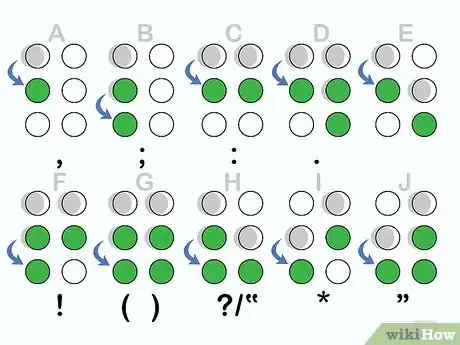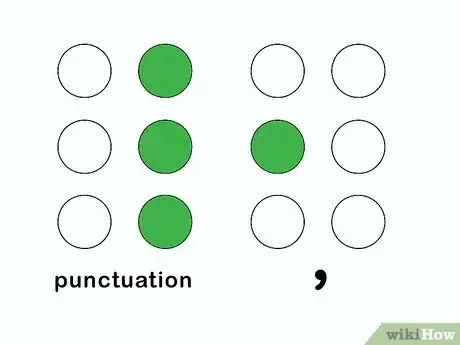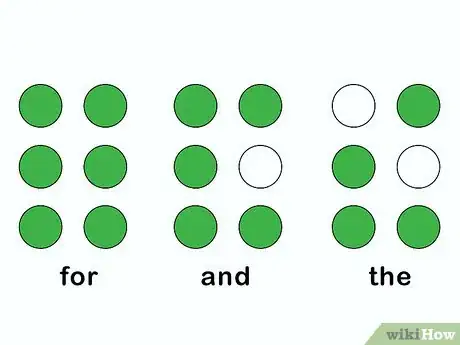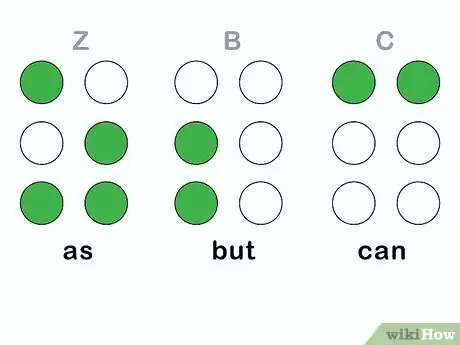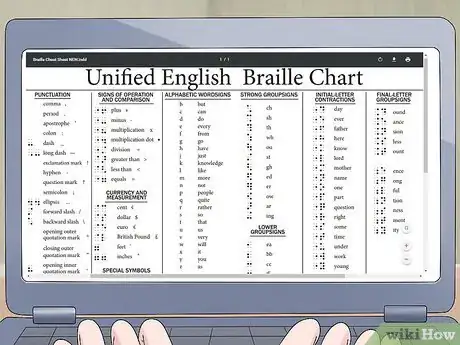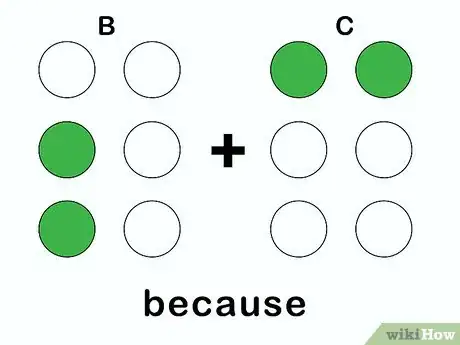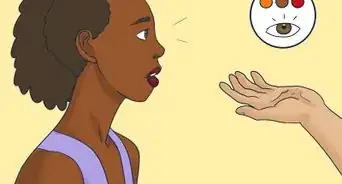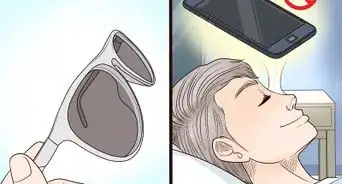This article was co-authored by wikiHow staff writer, Jennifer Mueller, JD. Jennifer Mueller is a wikiHow Content Creator. She specializes in reviewing, fact-checking, and evaluating wikiHow's content to ensure thoroughness and accuracy. Jennifer holds a JD from Indiana University Maurer School of Law in 2006.
There are 7 references cited in this article, which can be found at the bottom of the page.
wikiHow marks an article as reader-approved once it receives enough positive feedback. This article received 12 testimonials and 88% of readers who voted found it helpful, earning it our reader-approved status.
This article has been viewed 829,162 times.
Learn more...
Braille is a method of reading through touch, rather than by sight. While it is mainly used by those with impaired vision, sighted people can also learn to read Braille. You may think of Braille as a language. However, it's actually more like a code. There are Braille codes for nearly every language, as well as different types of Braille for specialized disciplines such as music, math, and computing.
Things You Should Know
- Braille letters and numbers are written in small, 6-dot cells.
- Each Braille letter and number has a different pattern of raised dots within a cell.
- Braille has specific codes for capital letters, punctuation marks, and certain shorthand words.
Steps
Printable Braille Alphabet
Learning the Letters of the Alphabet
-
1Seek out Braille instructional materials. Whether you are blind or sighted, there are numerous resources available for free that will help you learn the Braille code and start reading by touch. Search for nonprofit organizations dedicated to assisting people who are blind. Schools for the blind also have resources available to the general public.[1]
- The Hadley Institute for the Visually Impaired offers distance-learning courses for reading Braille. These courses are free for the visually impaired.
- You can also purchase Braille blocks and toys online to help with learning letters. These materials can be especially helpful for young children.
-
2Memorize the numbers for the 6 dots in a Braille cell. A standard Braille cell is made up of 6 dots arranged in 2 columns of 3 dots each. All of the dots are equal distance apart. The top left dot is numbered "1," the dot below it is "2," and the bottom dot in the first column is "3." The dots in the second column are numbered "4," "5," and "6" from top to bottom. Each Braille letter or symbol has a unique combination of dots and blank spaces.[2]
- Braille printed for the sighted may have "shadow dots" in the empty spaces, to help people see the positions of the dots more easily. Braille for the blind won't have shadow dots.
- To read Braille through touch, you need reasonably good finger sensitivity. Most adults have enough finger sensitivity to read Braille. If your finger sensitivity has been impacted by an injury or health condition, you may want to use "jumbo dot" Braille.[3]
Advertisement -
3Start with the first 10 letters of the alphabet. In the Braille code, the first 10 letters of the alphabet form the basis of all the other letters. These letters only use the top 4 dots in each cell. Thinking about the numbering of the dots in relation to the letter's place in the alphabet may help you learn them easier.
- The letter a has dot 1 only. This makes intuitive sense because a is the first letter of the alphabet. Likewise, the letter b has dot 1 and dot 2, for the second letter of the alphabet. The letter c has dot 1 and dot 4. The letter d has dots 1, 4, and 5. The letter e has dots 1 and 5.
- The letter f has dots 1, 2, and 4. The letter g has dots 1, 2, 4, and 5 – all 4 top dots are full. the letter h has dots 1, 2, and 5. You can think of g as adding dot 3 to letter f, and then h as taking away dot 4 from letter g.
- Unlike the previous 8 letters, the letters i and j do not have dot 1. The letter i has dots 2 and 4. The letter j has dots 2, 4, and 5.
-
4Add dot 3 to form the letters k through t. The Braille code follows a distinct pattern. The next 10 letters of the alphabet are formed by repeating the same dots as the first 10 letters, then adding dot 3 to each to form the new letter.
- For example, the letter k has 2 dots: the dot 1 from the letter a plus dot 3. Note that the letter l, with dots 1, 2, and 3, basically looks like the lower-case letter it represents.
-
5Add dot 6 to form u, v, x, y, and z. For the remaining letters (except w), take the k through o and add dot 6. Leave the letter w out completely, as it doesn't fit the pattern all the other letters do.
- The letter u has dot 1 and 3 from letter k, plus dot 6. The letter v has dots 1, 2, and 3 from letter l, plus dot 6.
- Since you're skipping w for now, the next letter is x, which has dots 1, 3, and 4 from letter m, plus dot 6. The letter y has dots 1, 3, 4, and 5 from letter n, plus dot 6. The letter z has dots 1, 3, and 5 from letter o, plus dot 6.
-
6Learn the letter w separately. The letter w is the only letter that doesn't fit the pattern. This is because the Braille code was invented by Frenchman Louis Braille in 1860. At the time, there was no w in the French alphabet, so Braille didn't include it in his code.
- A w has dot 2 on the left side, and dots 4, 5, and 6 on the right side.
Understanding Punctuation and Symbols
-
1Capitalize words preceded by a cell with a single dot 6. Braille doesn't have a separate code for capital letters. Rather, a cell with only dot 6 in front of a word indicates that the first letter in that word is capitalized.
- If 2 cells with only dot 6 appear before a word, it indicates that the whole word is written in all-caps.
-
2Drop down the first 10 letters for common punctuation marks. The Braille code for the first 10 letters of the alphabet is also used to create the most common punctuation marks you'll find in literary writing. The same code is simply dropped down to the lower part of the cell.[4]
- A Braille comma has dot 2. You can also think of this as a letter a dropped down one line.
- A Braille semicolon has dots 2 and 3. This is the letter b dropped down one line. A Braille colon has dots 2 and 5.
- A Braille period has dots 2, 5, and 6. The Braille period is also used as a decimal point. If there are 3 Braille periods together, they represent an ellipsis.
- An exclamation mark has dots 2,3, and 5, while a question mark has dots 2, 3, and 6.
- Quotation marks have 2 cells. The first represents whether they are single or double, and the second whether they are opening or closing. For single quotation marks, the first cell has dot 6. For double quotation marks, the first cell has dots 3 and 4. Opening quotation marks have dots 2, 3, and 6 (note that this is identical to a question mark). Closing quotation marks have dots 3, 5, and 6.
-
3Recognize when the first 10 letters are used as numbers. The Braille code for the first 10 letters of the alphabet also symbolizes numerals that may occur in sentences of text. If they're meant this way, they will be preceded by a special number sign (dots 3, 4, 5, and 6).
- The letter a is the number 1, all the way through the letter i, which is the number 9. The letter j is used for the number 0.
- There will only be 1 number sign, regardless of the length of the number.
- Commas and periods (for decimal points) are used in Braille numbers just as they are for numbers written in English. The mathematical comma has dot 6, rather than dot 2 as in the literary comma.[5]
- In the Nemeth code, used for math texts and in non-fiction writing, the codes for the first 10 letters of the alphabet are dropped down to the lower part of the Braille cell.[6]
-
4Look for the punctuation symbol with Nemeth code numerals. Nemeth code numerals and common punctuation symbols are the same. If a punctuation mark follows a mathematical expression, the punctuation symbol typically precedes the punctuation mark. This symbol tells you to read that symbol as a punctuation mark and not as another numeral.[7]
- The punctuation symbol has dots 4, 5, and 6. It typically precedes punctuation marks such as colons, periods, quotation marks, question marks, exclamation marks, commas, and semicolons.
Recognizing Contractions and Short-Form Words
-
1Identify single-cell contractions. For some of the most common contractions, a single letter or dot combination is used in place of an entire word. The purpose of these contractions is to save space and make reading easier.
- A full cell (all 6 dots) means for. If all dots are present except dot 5, you have the word and. Dots 2, 3, 4, and 6 together represent the word the.
-
2Read a separate single letter as a whole word. There are many commonly used words that are represented with a single letter of the alphabet. Usually that letter is the first letter of the word, although there are some exceptions. For example, the Braille code for the letter z can be used to symbolize the word as.[8]
- The letter b is used for the word but, and the letter c is used for the word can.
- Some of these abbreviations are also used in text-speak. For example, the letter v represents the word very.
-
3Learn letter combinations that are grouped into 1 cell. Many common letter combinations are contracted into 1 cell to save space and avoid repetition. These include common endings, such as -ed and -ing, as well as consonant blends such as ch and sh.[9]
- A chart, such as the one at https://www.teachingvisuallyimpaired.com/uploads/1/4/1/2/14122361/ueb_braille_chart.pdf, can help you memorize these contractions so that you can read more smoothly.
-
4Progress to short-form words. Not only does Braille use contractions, there are many words that are shortened even further. Some of these short-form words are more intuitive and easy to comprehend than others. Using a chart can help you memorize the ones you believe you need to know. Just add a few more each week as you continue to study.[10]
- For example, the Braille code for the letters b and l is used to represent the word blind.
- Some short-form words use a contraction along with another letter. For example, the contraction for be (dots 2 and 3) plus the letter c (dots 1 and 4) represents the word because.
Warnings
- This article focuses on learning to read English in Braille. Other languages have different characters or codes to represent letters of the alphabet, although the same cell system is used all over the world.[12]⧼thumbs_response⧽
References
- ↑ http://www.tsbvi.edu/braille-materials
- ↑ http://www.visionaware.org/info/everyday-living/essential-skills/reading-writing-and-vision-loss/all-about-braille/1235
- ↑ http://www.visionaware.org/info/everyday-living/essential-skills/reading-writing-and-vision-loss/all-about-braille/1235
- ↑ http://uebot.niu.edu/courses/pluginfile.php/96/block_html/content/UEB%20List%20of%20Punctuation.pdf
- ↑ http://www.brl.org/codes/session01/punc.html
- ↑ http://www.brl.org/codes/session01/numeric.html
- ↑ http://www.brl.org/codes/session01/punc.html
- ↑ https://www.teachingvisuallyimpaired.com/uploads/1/4/1/2/14122361/ueb_braille_chart.pdf
- ↑ https://www.teachingvisuallyimpaired.com/uploads/1/4/1/2/14122361/ueb_braille_chart.pdf
About This Article
Before reading Braille, you should know that each cell has 6 dots arranged in 2 columns of 3 dots each. Each dot is assigned a number, with the left column being 1, 2, 3 from top to bottom, and the right column being dots 4-6 in the same order. Once you understand the cells, learn the first 10 letters of the alphabet by memorizing which of the top 4 dots in a cell correspond to each letter. You can then follow the pattern of adding dot 3 to each of the first 10 letters to get the second 10 letters. Finally, you’ll have to memorize the last 6 letters, since they don’t follow the same pattern. To learn how to read punctuation in Braille, scroll down!

